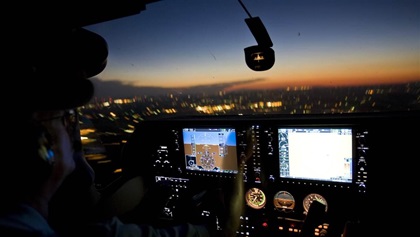What went wrong? Into the darkness
Nighttime carries extra risks

Things seem to settle into a quiet, patient rhythm that allows time to absorb the moment airborne and marvel at the wonder of it all.
The price for this peaceful bliss is additional risk. Some of the risk is unique to the dark; some of it exacerbated risk from typical daylight operations. Cockpit tasks seem to take longer—sometimes only seconds longer, but seconds make a difference in flying. A dropped pair of glasses is harder to find and reclaim; a switch may take a second glance or require a flashlight to find and set. The reduction in visibility outside can limit options and create added duress, which can impair cognitive function.
Uncertainty of the exact nature of the landscape surrounding the aircraft creates discomfort and an edginess. Emergencies or aircraft system problems are more challenging, as reduced cockpit visibility makes checklists harder to read and circuit breakers harder to locate and confirm. Limits to visibility and reduced acuity make locating and assessing alternate landing spots difficult. For older pilots, the biological makeup of the eyes and the effects of aging impair night vision capability even further.
Frequently, fatigue is an insidious hindrance to optimum performance at night. Most general aviation pilots flying at night do so after a long day, often at the office, dealing with tiring and draining issues. The fatigue factor is such an issue that in most professional aviation operations, a flying duty day is limited, often to 12 hours. Airlines absorb costs every year canceling or changing flights because pilots don’t meet crew rest requirements and FAA rules prevent them exceeding the crew duty day limitations These risks elevate the percentage of accidents at night that are fatal, compared to the percentage of total day accidents that are fatal.
Many of these elements seemed present in a fatal accident in 2018 involving two pilots, in a Cessna 210, flying a passenger from Kansas City, Missouri, to Frederick, Maryland. The pilots, both CFIs in their 60s, were at the end of a very long day, and this would be the proverbial last leg. Stopping in Columbus, Indiana (BAK) to refuel, they departed for Frederick in VFR conditions, with a 7,500-foot overcast and 10 miles visibility. Thirteen minutes after takeoff, 26 miles east of BAK and climbing through 7,000 feet on a northeasterly heading, the pilot transmitted “mayday” and reported partial engine failure.

Illustration by David Lindroth
The NTSB preliminary report would note damage to the number four piston and cylinder, which seems to confirm the pilots experienced a substantial loss of power. The pilot confirmed with the controller the nearest airport to be Batesville (HLB), 3.6 miles to the northeast, and advised he needed to “get down.” The controller confirmed Batesville as the nearest airport, but said lighting was uncertain, since the airport was closed according to notams. The pilot, frantically working to spot the airport and talking with the controller about the need for lighting, overflew Batesville at about 4,000 feet msl (3,000 feet agl). Still searching for the runway, and pleading for lighting, he extended 2 miles north of the field, then began a right 270-degree turn to a west heading. The airplane struck terrain about 1.5 miles north of the Batesville Runway 18 approach threshold; all on board perished.
The NTSB has not concluded its final analysis; however, the additional risks of night flying clearly played a role in this tragedy. The approximate gliding distance of a Cessna 210 at 6,000 feet agl is 9 miles. In the daytime, only 4 miles from the field, the pilots likely would have picked up Batesville and set up a glide path with plenty of altitude and distance to make the field. Almost certainly they would have been able to assess the 5,900-foot runway as suitable for emergency operations, and been able to execute a successful partial-power/engine-out pattern and landing. Or, this could have been one of the vast majority of off-airport landings that do not result in a fatality.
But on a dark night, gliding over a dark countryside, with just a sliver of a moon obscured by an overcast, two aging pilots on the tail end of a long day struggled to find the runway and overflew other locations suitable for an off-airport landing. Satellite imagery shows an expressway a mile south of the closed airport and numerous open fields in the vicinity of Batesville, which appear to be options for an emergency landing.
We’ll never know if fatigue from the long day contributed to impaired reaction times, reduced cognitive ability, and diminished night vision, but it’s reasonable to consider they could have been a factor. It’s unclear if the pilots noted during preflight planning that the Batesville airport was closed, and whether or not that was a factor in their preflight planning and routing. From radio transmissions released by the NTSB, the pilot seemed fixated on activating lighting on a closed runway as opposed to accepting the situation and focusing on an alternate plan: either finding an alternate location, or finding and landing at Batesville without lights.
The AOPA Air Safety Institute researched airfield closings and learned that on any given day, approximately 1 percent of airports across the United States are closed, for an average duration of 2.5 days. A good preflight planning technique is to annotate closed airfields, especially when flying at night; determine whether they would still be suitable for an emergency landing; and consider alternate routes if practical.
The pilot’s repeated transmissions with elevating anxiety indicate no one on board was able to penetrate the darkness and find the airfield, even as they overflew it at about 3,000 feet agl. Visual acuity in the darkness of the remote Indiana countryside would have required exceptionally good night vision. We won’t know whether they had reduced internal cockpit lighting to the minimum necessary and turned off flashlights to optimize night vision and reduce cockpit glare. We don’t know the avionics they had on board or whether they had an electronic flight bag with synthetic vision, but that certainly would have helped in their search.
We’ll never fully understand everything the pilots were dealing with in the cockpit, the extent of their challenges, or the entirety of all they considered—or didn’t consider—in their decision making. The final NTSB report is not likely to provide further insight on these areas. Regardless of its findings, we can learn from this scenario, apply lessons that may be helpful in updating our approach to night flying, and ultimately prevent a mishap in the future.
Email [email protected]

 Tips for night flying
Tips for night flying

